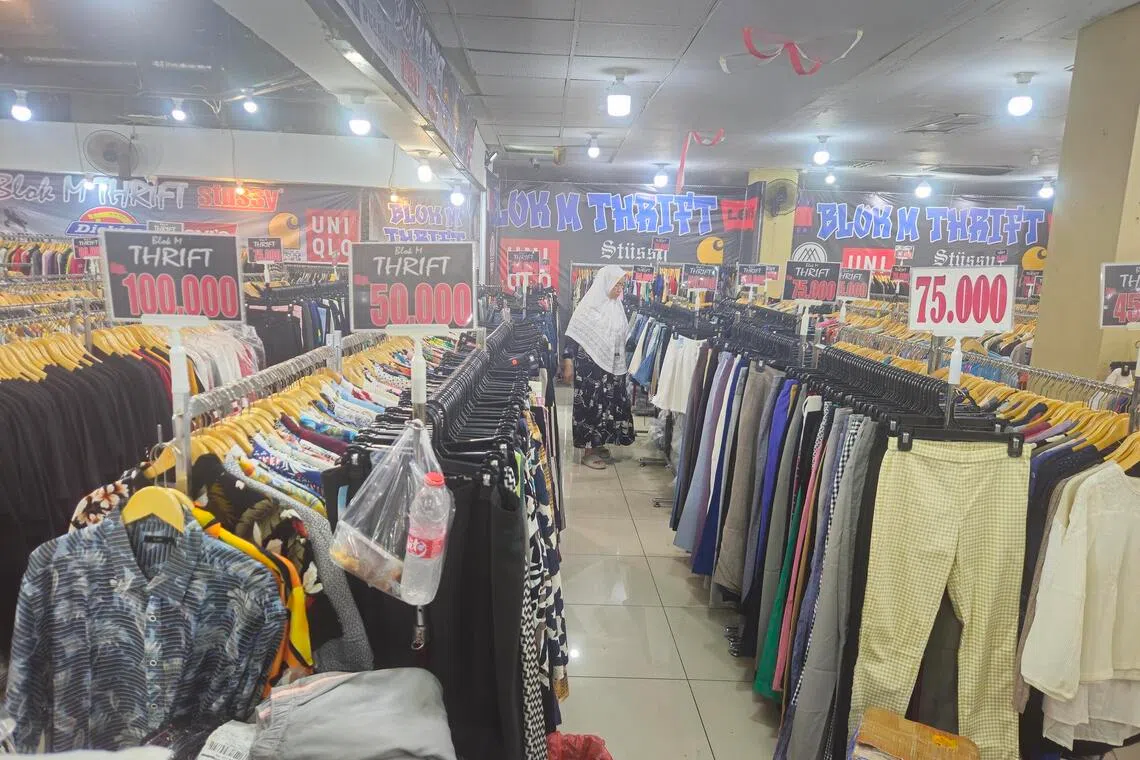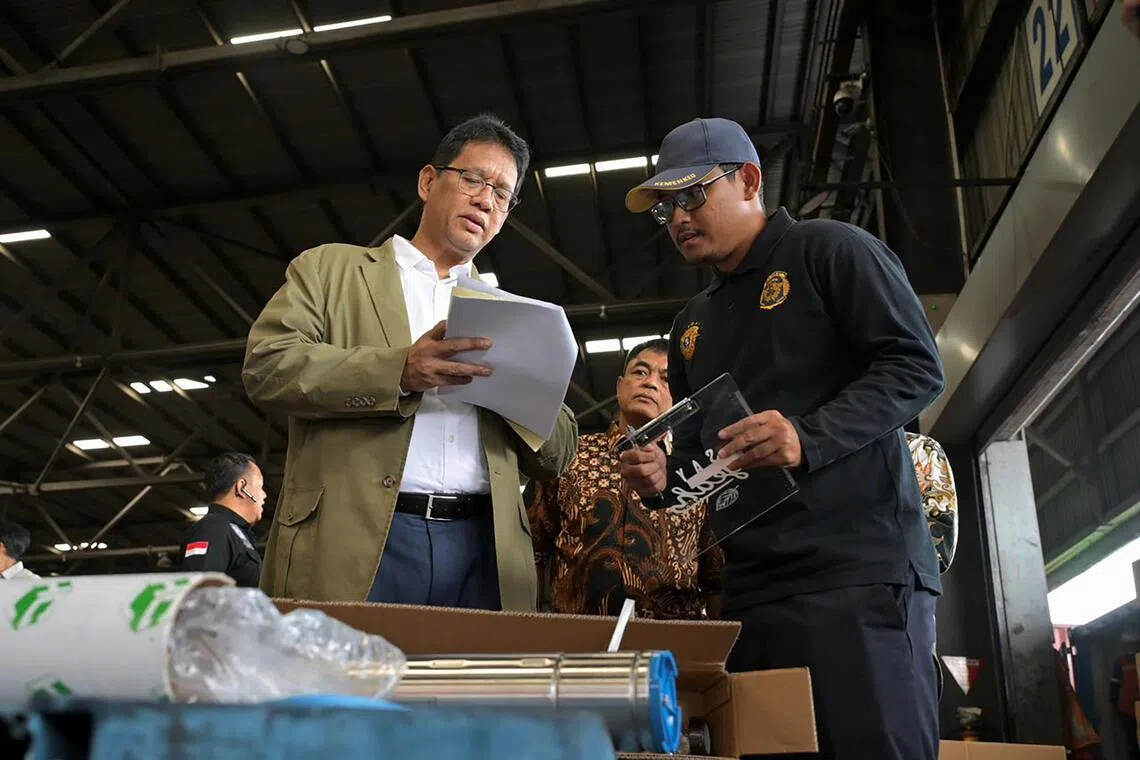‘Mouse seaports’ and rogue Customs officers: How used clothes get smuggled into Indonesia
Sign up now: Get insights on Asia's fast-moving developments

A second-hand clothing store in Blok M, South Jakarta.
ST PHOTO: WAHYUDI SOERIAATMADJA
Follow topic:
- Indonesia bans secondhand clothes imports due to health, environment, and harm to local textile industry, but illegal smuggling persists, often via major seaports.
- Finance Minister Purbaya Yudhi Sadewa is implementing stricter enforcement, including deploying internal auditors and banning rogue importers for life.
- Secondhand clothing sellers are protesting, arguing it provides affordable options and generates revenue, with some consumers citing its unique style and value.
AI generated
JAKARTA – In Indonesia, it is illegal to import second-hand clothes, for health and economic reasons. But this has not stopped syndicates from taking advantage of the country’s porous borders, weak enforcement and rogue Customs officers to smuggle in these goods.
The authorities have detected illegal garment shipments along the eastern part of Sumatra island, through the so-called “mouse seaports”, or tiny illegal ports spread along the coastline facing the Malacca Strait, said Finance Minister Purbaya Yudhi Sadewa at a recent briefing with reporters in Jakarta.
But he stressed that most of the illegal merchandise was imported through major seaports, like Jakarta and Surabaya, with the help of rogue Customs officers.
“Through these mouse seaports, you can bring in only so little and by small vessels that don’t carry those huge containers,” he said in response to a question from The Straits Times at the Nov 14 briefing.
“We are implementing the regulations more strictly on the ground. We will take stern measures when they (rogue Customs officers) get caught red-handed. We are deploying ‘itjen’ officers (internal auditors),” Mr Purbaya said.
Recalcitrant importers would be banned for life from importing any goods, he added.
Recent raids in West Java seized more than 19,000 bales of used garments worth over 112 billion rupiah (S$8.8 million), which sparked calls to investigate syndicates that channel goods mainly from developed countries. There is no estimated annual value for seized second-hand clothing.
While Malaysia and Singapore are transit points, Mr Purbaya said, Japan and South Korea have been the main source countries, according to Customs officers cited in local media reports.
Indonesia bans the import of used garments on the grounds that these pose health and environment risk, and harm the domestic textile industry.
Yet it is widely believed that more than 90 per cent of the second-hand clothes sold in Indonesia are illegal imports.
An industry player said up to a fifth of the domestic textile industry in Indonesia is eroded by the influx of second-hand apparel. The revenue of Indonesia’s clothing market in 2024 was estimated at US$22.65 billion (S$29.6 billion), compared with US$21.68 billion in 2023, according to Statista, a global data company.
Mr Nailul Huda, an economist with Jakarta-based think-tank Centre of Economic and Law Studies, noted that a piece of imported second-hand clothing can cost as little as 1,700 rupiah, compared with those produced locally that cost tens of thousands of rupiah each.
“Many textile factories here have had their production utilisation fall below 50 per cent due to the surge of imported second-hand clothing,” he told ST.

Indonesia bans the import of used garments on the grounds that these pose health and environment risk, and harm the domestic textile industry.
ST PHOTO: WAHYUDI SOERIAATMADJA
The surge in imported used clothes has hurt the competitiveness of local brands, noted Dr Esther Sri Astuti, executive director of the Jakarta-based Institute for Development of Economics and Finance. She added that the demand for the used clothing has continued to rise every year, without giving any figures.
However, the clampdown on imported second-hand clothing has been criticised by some.
On Nov 19, Mr Adian Npitupulu, an MP from the opposition Indonesian Democratic Party of Struggle, argued that millennials and Gen Zs prefer second-hand clothing as they noted that producing new garments requires large amounts of clean water and causes significant carbon emissions.
“Other countries, including the Netherlands, Russia and the US, allow imports of second-hand clothing. We should legalise thrifting. This would generate additional tax revenue for the state,” he said.
Second-hand clothing stores in Jakarta are feeling the heat.
Mr Faris Kahma, whose family runs a second-hand clothing shop in Blok M Square in South Jakarta, said the supply of second-hand clothing has started to tighten since Mr Purbaya announced sterner action against the import of these garments in October.
“We have felt the strain as a result of Purbaya’s remarks, but we are not sitting still,” Mr Faris told ST.
Another thrift clothing shop owner, Mr Rifai Silalahi, said his shop in Pasar Senen in Jakarta may see stocks depleted by the end of 2025. Pasar Senen has been the country’s largest hub for pre-loved garments for decades.
“If we run out of stocks, we will go to Purbaya’s residence and demand solution,” Mr Rifai said, stressing that the thrifting business in Pasar Senen employs thousands of people.

Finance Minister Purbaya Yudhi Sadewa (left) making an unscheduled inspection at a Customs office in Surabaya, in East Java province, on Nov 11.
INDONESIA’S FINANCE MINISTRY
On Nov 19, representatives of the thrifting business descended on Parliament to voice their concerns. Mr Faris argued that customers should have as many options as possible to pick from, stressing that thrifted clothing is usually favoured by the low- to lower-middle income class.
Second-hand clothing is unfairly singled out when illegal textile imports from China are the ones harming the domestic textile industry, he also said.
He noted that a brand new China-made tudung can be priced at just 2,000 rupiah, when the prices of his merchandise commonly range from 50,000 rupiah to 100,000 rupiah.
Mr Purbaya confirmed that “some of those items we found in the (illegal import) piles were also new clothing from an unsold inventory (of retailers) dumped here”.
“The massive inflows of brand new clothes to Indonesia – some were legal and some were illegal – also disrupted the market here. They are priced at about a third of the garments produced domestically,” Mr Danang Girindrawardana, executive director of the Indonesian Textile Association, told ST.
Mr Danang also said second-hand clothing imports are priced very competitively in Indonesia because they are not subject to import duties or value-added tax. Importers and sellers also evade income taxes.
Whether it is because of cost or other reasons, consumers remain keen on second-hand clothing.
Ms Sucy Chua, 32, a homemaker, is sceptical about the authorities’ claims of health risks posed by used garments.
She said she had never fallen ill from wearing such clothes, adding that she always washes them in hot water before wearing them. She noted that many thrift shops also clean their merchandise before selling them.
She enjoys thrifting because of the wide variety of vintage clothing offered, pieces that she believes carry both unique style and high value.
“You would never find anyone wearing the same outfit as you. If you buy something brand new from a modern store, there is a good chance you will see someone else wearing the exact same thing.”


